英语演讲课程总结
英语演讲实践周总结
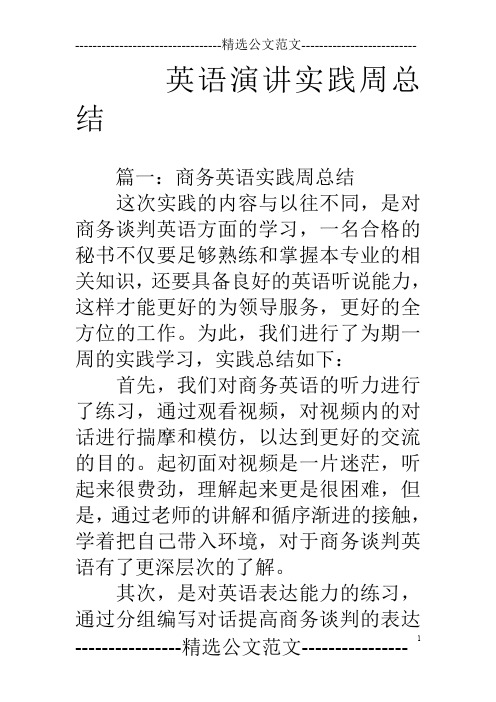
英语演讲实践周总结篇一:商务英语实践周总结这次实践的内容与以往不同,是对商务谈判英语方面的学习,一名合格的秘书不仅要足够熟练和掌握本专业的相关知识,还要具备良好的英语听说能力,这样才能更好的为领导服务,更好的全方位的工作。
为此,我们进行了为期一周的实践学习,实践总结如下:首先,我们对商务英语的听力进行了练习,通过观看视频,对视频内的对话进行揣摩和模仿,以达到更好的交流的目的。
起初面对视频是一片迷茫,听起来很费劲,理解起来更是很困难,但是,通过老师的讲解和循序渐进的接触,学着把自己带入环境,对于商务谈判英语有了更深层次的了解。
其次,是对英语表达能力的练习,通过分组编写对话提高商务谈判的表达能力。
对话内容设定为:假设你的公司派你与一家国外的公司进行某项业务的谈判,你需要对谈话内容进行设定,设置每一句话,组成一篇有条理内容丰富的对话。
编写对话的过程中对每一句话进行反复揣摩,进而提高表达能力以及商务英语谈判的能力。
最后,每一小组成员在熟练掌握本组的对话后,通过有感情的朗读背诵,呈现给老师和同学们。
通过这次的对话,大大提高了我们的英语水平以及商务谈判的技巧。
学习英语需要记住一句话:恒心和毅力是成功的必要条件。
但对我们千百万英语学习者来说,“什么是成功?”,成功就是把英语学到家,掌握英语,利用英语,使英语成为我们获取信息,工作学习,娱乐休闲的工具,真正成为英语的主人。
英语是一门综合性的学科,与其他课程内容紧密相联,所以我们应该将各科知识综合运用。
比如商务谈判英语、文秘英语、软件英语等等,在编写过程中我发现这些对开展工作的用处很大,这就要求我们广泛博览其他相关学科的书籍,多和同学和老师沟通,关注商务谈判的新发展,不断提高英语水平。
并且,商务谈判需要合适的表达——语场,指的是在交际过程中实际发生的事, 以及参与者所从事的活动, 其中语言活动是重要组成部分。
在商务谈判中,词汇、语法结构、习惯用语等已经形成了许多固定表达方式,尽管同样是英语,但是每个国家,不同的地区对英语的表达方式是不同的,表达方式的不当可能会造成一些不必要的尴尬和误会。
英语口语演讲团活动总结

英语口语演讲团活动总结
活动介绍
本次英语口语演讲团活动是由我们学校英语口语俱乐部组织的
一次团体活动。
活动旨在提高学生的英语口语能力并展示他们的演
讲技巧。
活动内容
1. 演讲选题:参与者可以自由选择演讲主题,展示他们的个人
见解和思考。
2. 演讲准备:参与者在活动前有足够的时间准备演讲内容,并
结合PPT等媒体进行展示。
3. 演讲比赛:在活动中设置了多个演讲比赛环节,参与者之间
进行实时竞争,评委根据内容和表达进行评分。
活动亮点
1. 话题多样性:参与者的演讲主题涵盖了社会热点、文化差异、个人成长等多个领域,展示了学生们的丰富知识和思考能力。
2. 表达能力提升:通过演讲活动,参与者的口语表达能力得到
了显著提升,他们学会了更好地组织语言、运用演讲技巧,有效地
传达自己的观点。
3. 团队合作:活动期间,参与者之间互相鼓励、帮助,形成了
紧密的团队合作氛围,提升了大家的集体凝聚力。
活动总结
本次英语口语演讲团活动圆满成功。
通过此次活动,学生们不
仅提高了英语口语能力,还增强了对社会问题的关注和思考。
同时,活动也为学生提供了一个展示自己的平台,激发了他们对英语研究
的兴趣。
我们将继续举办这样的活动,促进学生的全面发展。
参考资料
- 活动图片和视频(仅内部可见)
- 参与者演讲稿(仅内部可见)
- 活动评分统计表(仅内部可见)。
发言总结英语(精选3篇)
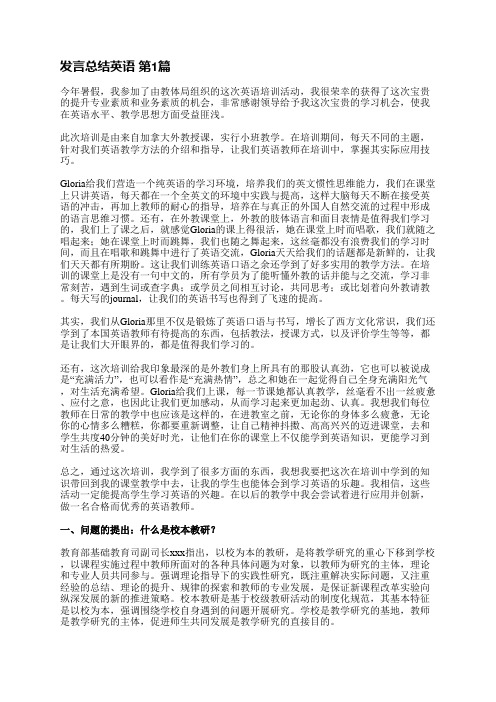
发言总结英语第1篇今年暑假,我参加了由教体局组织的这次英语培训活动,我很荣幸的获得了这次宝贵的提升专业素质和业务素质的机会,非常感谢领导给予我这次宝贵的学习机会,使我在英语水平、教学思想方面受益匪浅。
此次培训是由来自加拿大外教授课,实行小班教学。
在培训期间,每天不同的主题,针对我们英语教学方法的介绍和指导,让我们英语教师在培训中,掌握其实际应用技巧。
Gloria给我们营造一个纯英语的学习环境,培养我们的英文惯性思维能力,我们在课堂上只讲英语,每天都在一个全英文的环境中实践与提高,这样大脑每天不断在接受英语的冲击,再加上教师的耐心的指导,培养在与真正的外国人自然交流的过程中形成的语言思维习惯。
还有,在外教课堂上,外教的肢体语言和面目表情是值得我们学习的,我们上了课之后,就感觉Gloria的课上得很活,她在课堂上时而唱歌,我们就随之唱起来;她在课堂上时而跳舞,我们也随之舞起来,这丝毫都没有浪费我们的学习时间,而且在唱歌和跳舞中进行了英语交流,Gloria天天给我们的话题都是新鲜的,让我们天天都有所期盼。
这让我们训练英语口语之余还学到了好多实用的教学方法。
在培训的课堂上是没有一句中文的,所有学员为了能听懂外教的话并能与之交流,学习非常刻苦,遇到生词或查字典;或学员之间相互讨论,共同思考;或比划着向外教请教。
每天写的journal,让我们的英语书写也得到了飞速的提高。
其实,我们从Gloria那里不仅是锻炼了英语口语与书写,增长了西方文化常识,我们还学到了本国英语教师有待提高的东西,包括教法,授课方式,以及评价学生等等,都是让我们大开眼界的,都是值得我们学习的。
还有,这次培训给我印象最深的是外教们身上所具有的那股认真劲,它也可以被说成是“充满活力”,也可以看作是“充满热情”,总之和她在一起觉得自己全身充满阳光气,对生活充满希望。
Gloria给我们上课,每一节课她都认真教学,丝毫看不出一丝疲惫、应付之意,也因此让我们更加感动,从而学习起来更加起劲、认真。
理解当代中国英语演讲教程总结
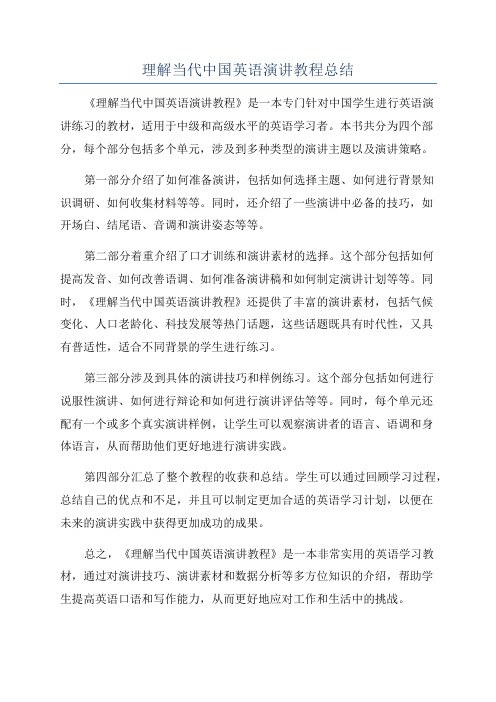
理解当代中国英语演讲教程总结
《理解当代中国英语演讲教程》是一本专门针对中国学生进行英语演
讲练习的教材,适用于中级和高级水平的英语学习者。
本书共分为四个部分,每个部分包括多个单元,涉及到多种类型的演讲主题以及演讲策略。
第一部分介绍了如何准备演讲,包括如何选择主题、如何进行背景知
识调研、如何收集材料等等。
同时,还介绍了一些演讲中必备的技巧,如
开场白、结尾语、音调和演讲姿态等等。
第二部分着重介绍了口才训练和演讲素材的选择。
这个部分包括如何
提高发音、如何改善语调、如何准备演讲稿和如何制定演讲计划等等。
同时,《理解当代中国英语演讲教程》还提供了丰富的演讲素材,包括气候
变化、人口老龄化、科技发展等热门话题,这些话题既具有时代性,又具
有普适性,适合不同背景的学生进行练习。
第三部分涉及到具体的演讲技巧和样例练习。
这个部分包括如何进行
说服性演讲、如何进行辩论和如何进行演讲评估等等。
同时,每个单元还
配有一个或多个真实演讲样例,让学生可以观察演讲者的语言、语调和身
体语言,从而帮助他们更好地进行演讲实践。
第四部分汇总了整个教程的收获和总结。
学生可以通过回顾学习过程,总结自己的优点和不足,并且可以制定更加合适的英语学习计划,以便在
未来的演讲实践中获得更加成功的成果。
总之,《理解当代中国英语演讲教程》是一本非常实用的英语学习教材,通过对演讲技巧、演讲素材和数据分析等多方位知识的介绍,帮助学
生提高英语口语和写作能力,从而更好地应对工作和生活中的挑战。
小学英语演讲比赛活动总结发言稿

大家好!今天,我很荣幸能够站在这里,向大家总结本次小学英语演讲比赛的活动情况。
首先,我要感谢学校领导、老师们为这次活动付出的辛勤努力,感谢同学们积极参与、热情投入。
在此,我宣布本次小学英语演讲比赛圆满结束!一、活动背景随着我国教育改革的不断深入,英语教育越来越受到重视。
为了激发同学们学习英语的兴趣,提高英语口语表达能力,我校举办了这次小学英语演讲比赛。
本次比赛旨在为广大同学提供一个展示自我、锻炼能力的舞台,让同学们在比赛中收获知识、提升自信。
二、活动组织1. 活动策划:学校领导高度重视本次比赛,成立了活动筹备小组,制定了详细的比赛方案,确保比赛的顺利进行。
2. 宣传发动:通过校园广播、海报、班级微信群等多种渠道,广泛宣传比赛活动,让全体同学了解比赛,积极参与。
3. 报名选拔:各班同学踊跃报名,经过初赛、复赛,最终选出优秀选手参加决赛。
4. 比赛准备:参赛选手在老师的指导下,认真准备演讲稿,反复练习,力求在比赛中展现最佳水平。
三、比赛过程1. 初赛:各班选手在班级内进行初赛,选出代表班级参加复赛的选手。
2. 复赛:各班代表选手在年级内进行复赛,角逐决赛名额。
3. 决赛:决赛分为两个环节,第一环节为自我介绍和演讲,第二环节为评委提问。
选手们精神饱满,表现优异,赢得了在场观众的热烈掌声。
四、活动成果1. 提高了同学们的英语口语表达能力:通过参加比赛,同学们在短时间内提升了英语口语水平,增强了自信心。
2. 培养了同学们的团队合作精神:在比赛过程中,同学们互相学习、互相鼓励,共同进步。
3. 丰富了校园文化生活:本次比赛为同学们提供了一个展示自我、锻炼能力的平台,丰富了校园文化生活。
4. 推动了英语教学工作:比赛激发了同学们学习英语的热情,为英语教学工作注入了新的活力。
五、活动总结1. 活动组织有序:本次比赛筹备工作充分,各个环节衔接紧密,确保了比赛的顺利进行。
2. 参赛选手表现突出:选手们积极参与,认真准备,展现了良好的精神风貌。
英语演讲总结怎么写
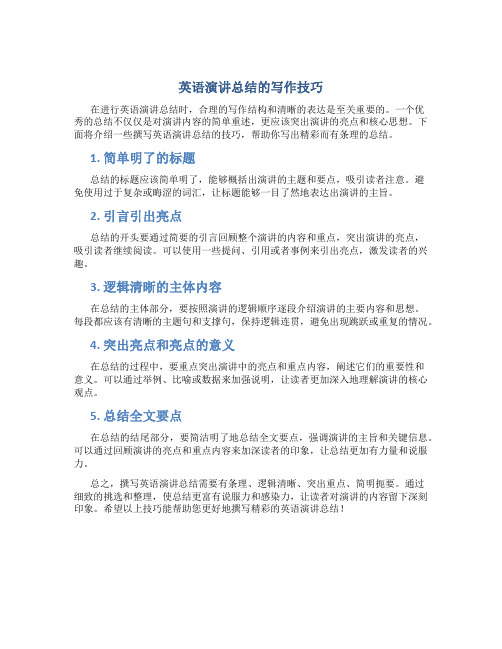
英语演讲总结的写作技巧
在进行英语演讲总结时,合理的写作结构和清晰的表达是至关重要的。
一个优
秀的总结不仅仅是对演讲内容的简单重述,更应该突出演讲的亮点和核心思想。
下面将介绍一些撰写英语演讲总结的技巧,帮助你写出精彩而有条理的总结。
1. 简单明了的标题
总结的标题应该简单明了,能够概括出演讲的主题和要点,吸引读者注意。
避
免使用过于复杂或晦涩的词汇,让标题能够一目了然地表达出演讲的主旨。
2. 引言引出亮点
总结的开头要通过简要的引言回顾整个演讲的内容和重点,突出演讲的亮点,
吸引读者继续阅读。
可以使用一些提问、引用或者事例来引出亮点,激发读者的兴趣。
3. 逻辑清晰的主体内容
在总结的主体部分,要按照演讲的逻辑顺序逐段介绍演讲的主要内容和思想。
每段都应该有清晰的主题句和支撑句,保持逻辑连贯,避免出现跳跃或重复的情况。
4. 突出亮点和亮点的意义
在总结的过程中,要重点突出演讲中的亮点和重点内容,阐述它们的重要性和
意义。
可以通过举例、比喻或数据来加强说明,让读者更加深入地理解演讲的核心观点。
5. 总结全文要点
在总结的结尾部分,要简洁明了地总结全文要点,强调演讲的主旨和关键信息。
可以通过回顾演讲的亮点和重点内容来加深读者的印象,让总结更加有力量和说服力。
总之,撰写英语演讲总结需要有条理、逻辑清晰、突出重点、简明扼要。
通过
细致的挑选和整理,使总结更富有说服力和感染力,让读者对演讲的内容留下深刻印象。
希望以上技巧能帮助您更好地撰写精彩的英语演讲总结!。
英语演讲比赛活动总结9篇

英语演讲比赛活动总结9篇第1篇示例:英语演讲比赛活动总结本次英语演讲比赛活动在XX年XX月XX日顺利举行,通过激烈的角逐,选出了优秀的演讲者和获奖选手。
活动中共有XX名参赛选手参与,他们围绕着“梦想与现实”、“未来与希望”等主题展开了精彩的演讲,展现了个人的才华和魅力。
各位选手在比赛中展现出了优秀的演讲能力和语言表达能力。
他们运用生动的语言、丰富的想象力和深刻的思考,表达了对梦想和未来的追求与渴望。
无论是关于个人成长、社会责任还是环境保护等议题,选手们都展现出了自己独特的见解和观点,引起了观众的共鸣和思考。
评委团队的专业评审和认真态度也为比赛增色不少。
评委们从演讲内容的逻辑性、表达的清晰度、演讲的气势和仪态等方面对选手进行了全方位的评判,确保评选出最具实力和潜力的获奖选手。
评审过程中,评委们给予了选手充分的鼓励和建议,帮助他们更好地提升演讲水平和表达能力。
观众们也积极参与到比赛中,为选手们加油助威,共同营造了热烈的比赛氛围。
他们认真聆听每位选手的演讲,用热烈的掌声和赞许的眼神支持着选手们,鼓励他们用最好的表现展现自己的才华和梦想。
观众们的积极参与不仅为比赛增添了活力,也为选手们提供了更多的动力和信心。
经过激烈的角逐,评选出了一、二、三等奖及优秀奖等各个奖项,表彰了优秀的演讲者和获奖选手。
通过比赛,选手们不仅获得了荣誉和奖励,更重要的是在比赛中成长和收获,提升了自身的演讲技巧和表达能力,拓展了自己的视野和思维,更加坚定了追求梦想和克服困难的信心与决心。
本次英语演讲比赛活动圆满成功,成绩斐然,展现了选手们的风采和才华,为学校的英语学习和演讲能力培养提供了一个很好的平台和机会。
希望在未来的比赛中,选手们能够继续努力进步,勇敢表达自己,展现自信与魅力,创造更加精彩的演讲世界。
让我们一起期待着下一次更加精彩的英语演讲比赛活动!感谢大家的参与和支持!第2篇示例:英语演讲比赛活动总结近日,我们学校举办了一场精彩的英语演讲比赛活动,参赛选手们展示了他们优秀的口才和思辨能力,为观众带来了一场精彩的英语盛宴。
英语演讲比赛活动总结7篇
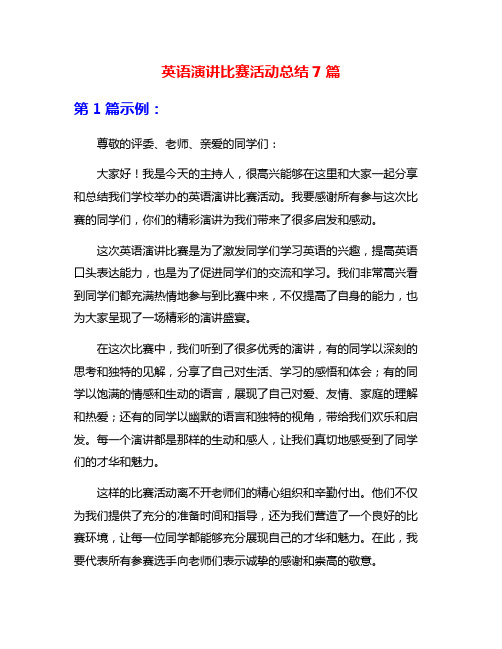
英语演讲比赛活动总结7篇第1篇示例:尊敬的评委、老师、亲爱的同学们:大家好!我是今天的主持人,很高兴能够在这里和大家一起分享和总结我们学校举办的英语演讲比赛活动。
我要感谢所有参与这次比赛的同学们,你们的精彩演讲为我们带来了很多启发和感动。
这次英语演讲比赛是为了激发同学们学习英语的兴趣,提高英语口头表达能力,也是为了促进同学们的交流和学习。
我们非常高兴看到同学们都充满热情地参与到比赛中来,不仅提高了自身的能力,也为大家呈现了一场精彩的演讲盛宴。
在这次比赛中,我们听到了很多优秀的演讲,有的同学以深刻的思考和独特的见解,分享了自己对生活、学习的感悟和体会;有的同学以饱满的情感和生动的语言,展现了自己对爱、友情、家庭的理解和热爱;还有的同学以幽默的语言和独特的视角,带给我们欢乐和启发。
每一个演讲都是那样的生动和感人,让我们真切地感受到了同学们的才华和魅力。
这样的比赛活动离不开老师们的精心组织和辛勤付出。
他们不仅为我们提供了充分的准备时间和指导,还为我们营造了一个良好的比赛环境,让每一位同学都能够充分展现自己的才华和魅力。
在此,我要代表所有参赛选手向老师们表示诚挚的感谢和崇高的敬意。
我要向所有获奖的同学表示热烈祝贺!你们的优秀表现是对自己不懈努力的肯定,更是对我们整个学校英语教学工作的肯定。
希望你们能够再接再厉,不断提高自己的英语口头表达能力,为我们学校争光添彩。
这次英语演讲比赛活动不仅为我们提供了一个展示自己的舞台,也增强了大家的英语学习信心和动力,更促进了同学们的交流和学习。
希望通过这样的比赛活动,我们能够更加热爱英语,更加自信地表达自己,让英语成为我们追求梦想的翅膀。
谢谢大家!第2篇示例:尊敬的领导、各位老师、亲爱的同学们:大家好!很高兴在这个美好的时刻,站在这里与大家分享一场精彩绝伦的英语演讲比赛活动。
本次比赛活动的成功举办离不开各位的大力支持和参与,特此向大家表示最诚挚的感谢!让我们回顾一下本次英语演讲比赛的整个流程。
英语演讲选修课期末复习最后大总结

chapter 1ABCWhy Study Public SpeakingIncrease personal and social abilitiesEnhance your academic and career skillsRefine your general communication abilitiesIncrease your public speaking abilities….Increase Personal and Social Abilitiesself-awarenessself-confidencedealing with the fear of communicatingPublic Speaking VS ConversationPurpose: both communicate with a certain purposeAudience: a public speech is usually directed at more listeners.Feedback: public speaking is relatively uninterrupted discourse.Delivery: public speaking requires intensified volume of voice and bodily action.Materials and organization: public speeches are mostly prepared ones. Impromptu speeches are rare.The essentials of a speechObjective: why am I making this speechAudience:whom am I making this speech toPlace:whereTime and lengthMethod of delivery:howContent:whatNotesRehearsal: identify weakness, practice difficult pronunciationsDealing with nervousnessAcquire speaking experiencePrepare, prepare, prepareThink positivelyUse the power of visualizationKnow that most nervousness is Not visibleDon’t expect perfectionAcquire Speaking ExperienceEnrolled in a public speaking courseStage fright: fear of the unknownLearning to give a speech is not much different from learning any other skill---it proceeds by trial and error. The purpose of your speech class is to shorten the process, to minimize the errors, to give you a nonthreatening arena---a sort of laboratory--- in which to undertake the “trial”Think positivelyConfidence is mostly the well-known power of positive thinking.Negative Thought & Positive ThoughtI wish I didn’t have to give this speech.This speech is a chance for me to share my ideas and gain experience as a speaker.I am not a great public speaker.No one is perfect, but I am getting better with each speech I give.TermsPositive nervousness---controlled nervousness that helps energize a speaker for her or his presentation.Visualization---mental imaging in which a speaker vividly pictures herself or himself giving a successful presentation.Creat a vivid mental blurprint in which you see yourself succeeding in your speechOther tips for dealing with nervousnessBe at your best physically and mentally. A good night’s sleep will serve you better.As you are waiting to speak, quietly tighten and relax your leg muscles, or squeeze your hands together and then release them. Such actions help reduce tension by providing an outlet for your extra adrenaline.Take a couple slow, deep breaths before you start to speak. Most people take short and shallow breaths, which only reinforces their anxiety. Deep breathing breaks this cycle of tension and help calm your nerves.Work especially hard on your introduction. Research has shown that a speaker’s anxiety level begins to drop significantly after the first 30 seconds of a presentationMake eye contact with members of your audience. Remember that they are individual people, not a blur of faces. And they are your friends.Concentrate on communicating with your audience rather than on worrying about your stage fright. If you get caught up in your speech, your audience will too.Use visual aids. They create interest, draw attention away from you, and make you feel less self-conscious.chapter 2 topicSelecting a topicSpeeches outside the classroomthe occasion, the audience, the speaker’s qualificationsSpeeches in the public speaking classno designated topicWhat is a suitable speech topicWorthwhileAppropriateLimited in scopeSuitable topicWorthwhilesignificant implications for the audienceAppropriateknow a lot, like to learn moreLimited in scopedividing the topic into several significant parts.General purpose: the broad goal 总体目标To inform: convey informationenhance the knowledge and understandingTo persuade: advocate or partisanChange or structure the attitudes or actionsDifference: explain or exhortSpecific purpose 具体目标to inform my audience about…to per suade my audience to …Explain ←→exhortSpecific PurposeSpecific purpose: ( single infinitive phrase that states precisely what a speaker hopes to accomplish in his or her speech.). 简单的肯定句Topic: EmergenciesGeneral purpose: To informSpecific purpose: To inform my audience of the major steps in responding to an emergencyTips for formulating the specific purpose statementTip 1: Write the purpose statement as a full infinitive phrase(完整的短语), not as a fragment (片段)Tip 2Express your purpose as a statement, not as a question陈述句Tip 3 Avoid figurative language比喻语言Tip 4 Limit your purpose statement to one distinct idea, or one main pointTip 5Make sure your specific purpose is not too vague or generalPhrasing the central idea(Also called thesis statement, subject sentence, major thought )What is the central ideaGuidelines for the central ideaWhat is the central ideaA one-sentence statement that sums up the major ideas of a speech. It is what you wantthe audience to absorb from your speech.In persuasive speechesarguable, debatable, take your stanceIn informative speechesrelatively neutral and objectiveThe specific purpose of a speech is what you hope to accomplish.The central idea is a concise statement of what you expect to say.Guidelines for the central ideaThe central idea1. Should be expressed in a full sentencenot be in the form of a question.3. should avoid figurative language4. should not be vague or overly generalSummarySelecting a topicDetermining your general purposeDetermining your specific purposePhrasing your central ideaFour brainstorming proceduresMake a quick inventory of your hobbies, interests, skills, experiences, beliefs, and so forth.Use the technique of clustering and write down on a sheet of paper the first topics that come to mind in several categories.Look through a reference work for ideasUse a World Wide Web subject directory such as Yahoo to help you scan possible topic.chapter 3 AnalysisAnalyzing the audience1. Audience-centeredness 以听众为中心2. The psychology of audience 听众的心理3. Demographic audience analysis 听众分析统计4. Situational audience analysis 听众分析的具体情形5. Adapting to the audience 适应听众1. Audience-centerednessAudience-centeredness: keeping the audience foremost in mind at every step of speech preparation and presentation.Questions to be asked when preparingTo whom am I speakingWhat do I want them to know, believe, or do as a result of my speechWhat is the most effective way of composing and presenting my speech to accomplish that aim(how)2. The psychology of audiencesQuestion: what do you do when you listen to a speechtwo messages:speaker, filter, listenerpeople hear what they want to hear and disregard the rest.Question: what do people want to hearMeaningfulEgocentrism: The tendency of people to be concerned above all with their own values, beliefs, and well-being.Listeners typically approach speeches with one question uppermost in mind: “Why is this important to me”What do these psychological principles mean to you as a speakerListeners: what they already knowSpeakers: relate the message toTwo steps of demographic audience analysis⑴identifying the general demographic features of your audience⑵assessing the importance of those features to a particular speaking situationDemographic Audience AnalysisAgeGenderSexual orientationRacial, ethnic and cultural backgroundReligion4. Situational audience analysis:Situational factorsSizePhysical settingDisposition toward the topicDisposition toward the speakerDisposition toward the topicInterestKnowledgeAttitudeDisposition toward the speakerkeep in mind that your listeners will always have some set of attitudes toward you as a speaker.Estimating what those attitudes are and how they will affect your speech is a crucial part of situational audience analysis.Summaryaudience-centered.They know that the aim of speechmaking is to gain a desired response from listeners. When working on your speeches, keep three questions in mind:(1)To whom am I speaking(2)What do I want them to know, believe, or do as a result of my speech(3)What is the most effective way of composing and presenting my speech to accomplish that aimPsychology of audience.People hear what they want to hear.EgocentricWhy is this important to mechapter4 ntroduction1. Getting attention and interest(1)Relate the topic to the audience(2)State the importance of your topic(3)Startle the audience(4)Arouse the curiosity of the audience(5)Question the audience(6)Begin with a quotation(7)Tell a story2. Reveal the topic3. Establish credibilityCredibility: the audience’s perception of whether a speaker is qualified to speak on a given topic.Your credibility need not be based on firsthand knowledge and experience. It can come from reading, from classes, from interviews, from friends.4 Preview the body of the speechPreview statement 预先叙说A statement in the introduction of a speech that identifies the main points to bediscussed in the body of the speech.Tips for preparing the introduction1.Keep the introduction relatively brief. Under normal circumstances it should notconstitute more than 10 to 20 percent of your speech.2. Be on the lookout for possible introductory materials as you do your research. File them with your notes, so they will be handy when you are ready for them.3. Be creative in devising your introduction. Experiment with two or three different openings and choose the one that seems most likely to get the audience interested in your speech.4. Don’t worry about the exact wording of your introduction until you have finished preparing the body of the speech. After you have determined your main points, it will be much easier to make final decisions about how to begin the speech.5. Work out your introduction in detail. Some teachers recommend that you write it out word for word; others prefer that you outline it. Whichever method you use, practice the introduction over and over until you can deliver it smoothly from a minimum of notes and with strong eye contact. This will get your speech off to a good start and give you a big boost of confidence.Some common faults of introductionsDon’t apologize.Don’t pretendDon’t make hollow promises Don’t rely on gimmicksDon’t preface your introductionchapter 5 conclusionTo let the audience know you are ending the speech•“In conclusion”•“One last thought”•“In closing”•“My purpose has been”•“Let me end by saying”Reinforce the central idea1. Summarize your speech2. End with a quotation3. Make a dramatic statement4. Refer to the introduction5. MotivateTips for preparing the conclusion1. As with the introduction, keep an aye out for possible concluding materials as you research and develop the speech.2. Conclude with a bang, not a whimper. Be creative in devising a conclusion that hits the hearts and minds of your audience. Work on several possible endings, and select the one that seems likely to have the greatest impact.3.Do not be long-winded. The conclusion will normally make up no more than about 5 to10 percent of your speech. Nothing aggravates audiences more than a speaker who says,“In conclusion”and keeps on talking.chapter 6 -7 language_deliveryLanguage is importantMeaning of wordsUsing language accuratelyUsing language clearlyUsing language vividlyUsing language appropriatelyA note on inclusive languageUsing language clearly1. Use familiar words2. Choose concrete words3. Eliminate clutter2. Choose concrete wordsConcrete words: words that refer to tangible objectsAbstract words: words that refer to ideas or conceptsKeep this in mind: few words are completely abstract or concrete. Abstractness and concreteness are relative.Two main ways to use moving and vivid language: imagery and rhythm1. Imagery: (意象)The use of vivid language to create mental images of objects, actions or ideas.It is a word picture that gets you totally involved.Three ways to generate imagery:A. Concrete wordsB. Simile(明喻)An explicit comparison introduced with the word “like” or “as” between things that are essentially different yet have something in common. Example:C. Metaphor (暗喻)Unlike simile, metaphor does not contain the words “like” or “as”.2. Rhythm(节奏)The pattern of sound in a speech created by the choice and arrangement of words.Four basic stylistic devices to improve the rhythmA. Parallelism(排比): the similar arrangement of a pair or series of related words, phrases, or sentences. Examples:①Rich and poor, intelligent and ignorant, wise and foolish, virtuous and vicious, man and woman---it is ever the same, each soul must depend wholly on itself.(Elizabeth Cady Stanton)②There is no Negro problem. There is no Southern problem. There is no Northern problem. There is only an American problem. (Lyndon Johnson)③I speak as a Republican. I speak as a woman. I speak as a United Sates Senator. I speak as an American.(Margaret Chase Smith)B. RepetitionRepeating the same word or set of words at the beginning or end of successive clauses or sentences①When you see your street, see my street. When you see your house, see my house. When you see your children, see my children. (Whitney Young, Jr.)②We will not tire, we will not falter, we will not fail. (George W .Bush)C. Alliteration(头韵法)Repetition of the initial consonant sound of close or adjoining words. Examples:①Peace is essential for progress, but progress is no less essential for Peace. (Liaquat Ali Khan)②In a nation founded on the promise of human dignity, our colleges, our communities, our country should challenge hatred wherever we find it. (Hillary Rodham Clinton)D. Antithesis 对比法The juxtaposition of contrasting ideas, usually in parallel structure. Examples:①Ask not what your country can do for you; ask what you can do for your country. (John. F. Kennedy)②Your success as a family, our success as a society, depends not on what happens at the White House, but on what happens inside your house. (Barbara Bush)Using language appropriately恰当地使用语言1. Appropriate to the occasion2. Appropriate to the audience3. Appropriate to the topic4. Appropriate to the speakerA NOTE ON INCLUSIVE LANGUAGEInclusive language: language that does not stereotype, demean, or patronize people on the basis of gender, race, religion, disability, sexual orientation, or other factors.Four basic methods of delivering a speechReading from a manuscript: A speech that is written out word for word and read to the audience.Reciting from memorySpeaking impromptu: a speech delivered with little or no immediate preparation.Speaking extemporaneously: A carefully prepared and rehearsed speech that is presented from a brief set of notes.The speaker’s voiceThe aspects of voice you should work to control are:Volume 音量Pitch 音高Rate 频率Pauses 停顿Vocal variety 嗓音变化PronunciationThe speaker’s voicevolume : the loudness or softness of the speaker’s voice.Pitch: t he highness or lowness of the speaker’s voice.Rate: the speed at which a person speaks.The speaker’s body1. Personal appearance2. Movement3. Gestures4. Eye contactThere are four basic methods of delivering a speech, They areReading from a manuscript.Reciting from memorySpeaking impromptuSpeaking extemporaneouslychapter 8 SpecialSpeeches on special occasions1. Speech of introduction介绍性演讲2. Speech of presentation赠与演讲3. Speeches of acceptance受奖演讲4. Speeches of tribute赞扬5. Speeches of welcome 欢迎6. Speech of farewell欢送1. Speech of introductiona speech that introduces the main speaker to the audience.Three purposes be achieved in the introductionBuild enthusiasm for the upcoming speakerBuild enthusiasm for the speaker’s topicEstablish a welcoming climate that will boost the speaker’s credibilityGuidelines for speeches of introductionBe briefMake sure your remarks are completely accurateDon’t take the speaker’s jobAdapt your remarks to the main speakerTry to create a sense of anticipation and dramaAdapt your remarks to the audience比尔盖茨在清华大学的演讲.flv2. Speech of presentationA speech that presents someone a gift, an award, or some other form of publicrecognitionGuidelinesState the purpose of the awardFocus on the accomplishments of the recipientAvoid over-praising3. Speeches of acceptanceA speech that gives thanks for a gift, an award, or some other form of public recognitionA speech of acceptance usually includes the following three steps.The first stepThank those who grant you the awardThe second stepThank those who helped you attain the award.The third stepAccept the award graciously4.Speeches of tribute5. A speech that honors a person, a group or an event.6. A special form of the speech of tribute is the eulogy, a speech of praise usually given forthose who have recently died. A minister performing a funeral usually gives a speech of eulogy by praising and honoring the deceased.Speeches of tribute 我有一个梦想.flvEstablish noble themesBe sincereConnect with the audienceAppeal to the audiencechapter 9 supportingThree kinds of supporting materialsexamples 实例testimony 证词statistics 统计数据Hypothetical exampleAn example that describes an imagery or fictitious situation 描述的是想象或虚构的情形Tips for using examples1. Use examples to clarify your ideas说明2. Use examples to reinforce your ideas强化3. Use examples to personalize your ideas使思想个人化II.TestimonyTestimony ---quotations or paraphrases used to support a point.引用或释义的用于支持观点的话---Expert testimony 专家证词---Peer testimony 普通人证词Tips for Using testimony1. quote or paraphrase accurately: make sure you do not misquote someone; make sure you do not violate the meaning of statements you paraphrase; make sure you do not quote out of context2. Use testimony from qualified sources. That is, use testimony from recognized experts or ordinary citizens with special experience on the speech topic.3. Use testimony from unbiased sources. Be sure to use testimony from credible, competent, objective authorities.4. Identify the people you quote or paraphrase. The usual way to identify your source is to name the person and sketch her or his qualifications before presenting the testimonyask yourself the following two questions:Are the statistics representativeAre the statistics from a reliable sourceTips for using statistics1. Use statistics to quantity your ideas2. Use statistics sparingly3. Identify the source of your statistics4. Explain your statistics5. Round off complicated statistics6. Use visual aids to clarify statistical trendsChapter 10 informativeInformative speech: a speech designed to convey knowledge and understandingTo enhance the knowledge and understanding of your listeners--- to give them information they did not have beforeConvey clearly accurately interestinglyOrganizational methodsChronological order 编年顺序Spatial order 空间顺序Topical order 主题顺序Causal orderProblem-solution orderOther methods of speech organizationCausal order:A show a cause-effect relationship. method of speech organization in which the main pointsProblem-solution order: A method of speech organization in which the first main point deals with the existence of a problem and the second main point presents a solution to the problem.(Problem-cause-solution order)Speeches about processProcess: A systematic series of actions that leads to a specific result or product.Speeches of process explain how something is made, how something is done, or how something works.3. Speeches about eventsEvent: Anything that happens or is regarded as happening.chronological order----to recount the history of an event,causal order ----to explain the causes and effects4. Speech about conceptsConcept: A belief, theory, idea, notion, principle, or the like.Speeches about concepts are usually organized in topical order. One common approach is to list the main features or aspects of your concept.Guidelines for informative speakingDon’t overestimate what the audience knows.* Lead your audience step by step and explain everything thoroughly.2. Relate the subject directly to the audience* What is fascinating to the speaker may not be fascinating to everybody.* Get your listeners involved3. Don’t be too technical* Simple, clear language is needed.4. Avoid abstractionsOne way to avoid abstractions is through description (a statement that depicts a person, event, idea, or the like with clarity and vividness)Another way to escape abstraction is with comparisons (A statement of the similarities among two or more people, events, ideas, etc.)5. Personalize your ideaschapter11 persuasiveI. Persuasive speeches on questions of factQuestions of fact ---A question about the truth or falsity of an assertion.We do not know enough information to know what it isWill the economy be better or worse next yearWill another earthquake strike California before the year 2010The facts are murky or inclusiveWhat will happen next in the Middle EastIs sexual orientation genetically determinedSpeeches On questions of fact are usually organized topicallyII. Persuasive speeches on questions of valueQuestions of value ---A question about the worth, rightness, morality, and so forth of an idea or action.What is the best movie of all time Is the cloning of human beings morally justifiable What are the ethical responsibilities of journalistsMatter of fact, value judgmentsSpeeches on questions of value are mostly organized topicallyYour first main point is to establish the standards for your value judgment. 树立价值判断的标准Your second main point is to apply those standards to the subject.III. Persuasive speeches on questions of policyQuestions of policy ---A question about whether a specific course of action should or should not be taken.是否采取行动What to do during spring vocationWhich strategy to use in selling a productHow to maintain economic growth and protect the enviromentThey are to decide whether something should or should not be done.2. Organizing speeches on Questions of policyProblem-solution orderProblem-cause-solution orderComparative Advantage orderD. Monroe’s motivated sequenceD. Monroe’s motivated sequence门罗促动顺序A method of organizing persuasive speeches that seek immediate action.The five steps of the motivated sequence are:1. attention2. need3. satisfaction4. visualization(形象化)5. actionPart 2: Methods of persuasionListeners will be persuaded by a speaker from one or more of four reasons:I. credibility.II. evidence.III. reasoning.IV. emotionsI. Building credibilityFactors of credibility:A. Competence---how an audience regards a speaker’s intelligence, expertise, and knowledge of the subject.B. Character---how an audience regards a speaker’s sincerity, trustworthiness, and concern for the well-being of the audience.2. Establishing common ground with your audienceCreating common ground---a technique in which a speaker connects himself or herself with the values, attitudes, or experiences of the audience.3. Deliver your speeches fluently, expressively, and with convictionII. Using evidenceTips for using evidence1. Use specific evidence.2. Use novel evidence.3. Use evidence from credible sources4. Make clear the point of your evidence.III. ReasoningReasoning---the process of drawing a conclusion on the basis of evidence.Four types of reasoning:1. Reasoning from specific instances2. Reasoning from principle3. Causal reasoning4. Analogical reasoningGuidelines for reasoning from specific instancesA. Avoid generalizing too hastily, make sure your sample of specific instances is large enough to justify your conclusion.B. Be careful with your wording. If your evidence does not justify a conclusion, qualify your argument.C. Reinforce your argument with statistics and testimony2. Reasoning from principle---Reasoning that moves from a general principle to a specific conclusion. For instance:All people are mortal.Socrates is a person.Therefore, Socrates is mortal.3. Causal reasoning---Reasoning that seeks to establish the relationship between causes and effects.There is a patch of ice on the sidewalk. You slip, fall, and break your arm. You reason as fol lows: “Because that patch of ice was there, I fell and broke my arm.” or“If the patch of ice hadn’t been there, I wouldn’t have fallen and broken my arm.”4. Analogical reasoning(类比推理)---Reasoning in which a speaker compares two similar cases and infers that what is true for the first case is also true for the second.If you are good at racquetball, you’ll be great at Ping-Pang.In Great Britain the general election campaign fro Prime Minister lasts less than three weeks. Surely we can do the same with the presidential election.IV. Appealing to emotionsEmotional appeals are intended to make listeners feel sad, angry, guilty, afraid, happy, proud, sympathetic, reverent, or the like. These are often appropriate reactions when the question is one of value or policy.Guidelines for generating emotional appeal1. Use emotional language2. Develop vivid example3. Speak with sincerity and conviction。
英语说课教学总结与反思6篇

英语说课教学总结与反思6篇(最新版)编制人:__________________审核人:__________________审批人:__________________编制单位:__________________编制时间:____年____月____日序言下载提示:该文档是本店铺精心编制而成的,希望大家下载后,能够帮助大家解决实际问题。
文档下载后可定制修改,请根据实际需要进行调整和使用,谢谢!并且,本店铺为大家提供各种类型的经典范文,如工作总结、报告大全、演讲致辞、条据书信、心得体会、党团资料、读后感、作文大全、教学资料、其他范文等等,想了解不同范文格式和写法,敬请关注!Download tips: This document is carefully compiled by this editor.I hope that after you download it, it can help you solve practical problems. The document can be customized and modified after downloading, please adjust and use it according to actual needs, thank you!In addition, this shop provides you with various types of classic sample essays, such as work summary, report encyclopedia, speeches, articles and letters, experience and experience, party and group information, after reading, composition encyclopedia, teaching materials, other sample essays, etc. I want to know the difference Please pay attention to the format and writing of the sample essay!英语说课教学总结与反思6篇写教学总结的目的,就是希望自己的能力有所提升,教学总结是为了我们在教学中发现问题,吸取教训,看看是否有什么不足需要改正,以下是本店铺精心为您推荐的英语说课教学总结与反思6篇,供大家参考。
总结英语演讲(必备3篇)
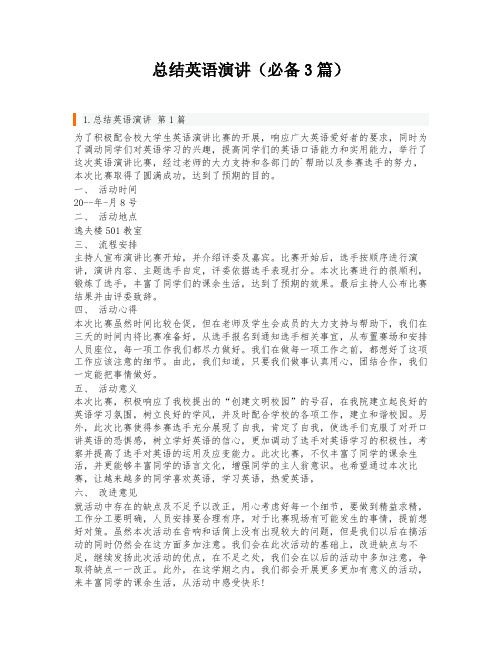
总结英语演讲(必备3篇)1.总结英语演讲第1篇为了积极配合校大学生英语演讲比赛的开展,响应广大英语爱好者的要求,同时为了调动同学们对英语学习的兴趣,提高同学们的英语口语能力和实用能力,举行了这次英语演讲比赛,经过老师的大力支持和各部门的`帮助以及参赛选手的努力,本次比赛取得了圆满成功,达到了预期的目的。
一、活动时间20--年-月8号二、活动地点逸夫楼501教室三、流程安排主持人宣布演讲比赛开始,并介绍评委及嘉宾。
比赛开始后,选手按顺序进行演讲,演讲内容、主题选手自定,评委依据选手表现打分。
本次比赛进行的很顺利,锻炼了选手,丰富了同学们的课余生活,达到了预期的效果。
最后主持人公布比赛结果并由评委致辞。
四、活动心得本次比赛虽然时间比较仓促,但在老师及学生会成员的大力支持与帮助下,我们在三天的时间内将比赛准备好,从选手报名到通知选手相关事宜,从布置赛场和安排人员座位,每一项工作我们都尽力做好。
我们在做每一项工作之前,都想好了这项工作应该注意的细节。
由此,我们知道,只要我们做事认真用心,团结合作,我们一定能把事情做好。
五、活动意义本次比赛,积极响应了我校提出的“创建文明校园”的号召,在我院建立起良好的英语学习氛围,树立良好的学风,并及时配合学校的各项工作,建立和谐校园。
另外,此次比赛使得参赛选手充分展现了自我,肯定了自我,使选手们克服了对开口讲英语的恐惧感,树立学好英语的信心,更加调动了选手对英语学习的积极性,考察并提高了选手对英语的运用及应变能力。
此次比赛,不仅丰富了同学的课余生活,并更能够丰富同学的语言文化,增强同学的主人翁意识。
也希望通过本次比赛,让越来越多的同学喜欢英语,学习英语,热爱英语,六、改进意见就活动中存在的缺点及不足予以改正,用心考虑好每一个细节,要做到精益求精,工作分工要明确,人员安排要合理有序,对于比赛现场有可能发生的事情,提前想好对策。
虽然本次活动在音响和话筒上没有出现较大的问题,但是我们以后在搞活动的同时仍然会在这方面多加注意。
英语演讲总结反思报告
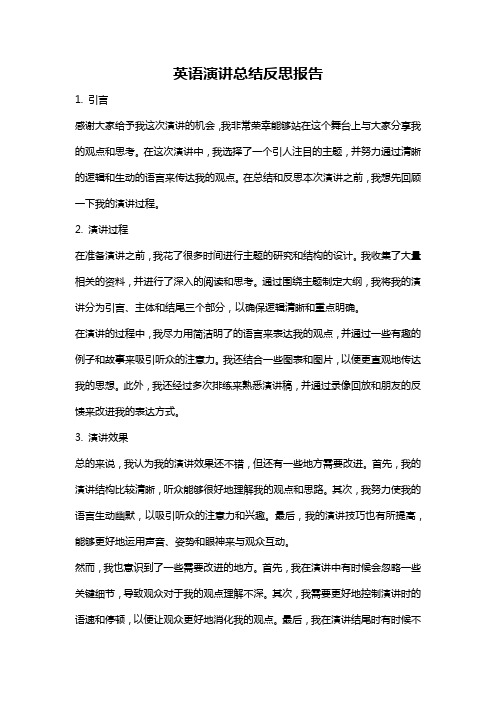
英语演讲总结反思报告1. 引言感谢大家给予我这次演讲的机会,我非常荣幸能够站在这个舞台上与大家分享我的观点和思考。
在这次演讲中,我选择了一个引人注目的主题,并努力通过清晰的逻辑和生动的语言来传达我的观点。
在总结和反思本次演讲之前,我想先回顾一下我的演讲过程。
2. 演讲过程在准备演讲之前,我花了很多时间进行主题的研究和结构的设计。
我收集了大量相关的资料,并进行了深入的阅读和思考。
通过围绕主题制定大纲,我将我的演讲分为引言、主体和结尾三个部分,以确保逻辑清晰和重点明确。
在演讲的过程中,我尽力用简洁明了的语言来表达我的观点,并通过一些有趣的例子和故事来吸引听众的注意力。
我还结合一些图表和图片,以便更直观地传达我的思想。
此外,我还经过多次排练来熟悉演讲稿,并通过录像回放和朋友的反馈来改进我的表达方式。
3. 演讲效果总的来说,我认为我的演讲效果还不错,但还有一些地方需要改进。
首先,我的演讲结构比较清晰,听众能够很好地理解我的观点和思路。
其次,我努力使我的语言生动幽默,以吸引听众的注意力和兴趣。
最后,我的演讲技巧也有所提高,能够更好地运用声音、姿势和眼神来与观众互动。
然而,我也意识到了一些需要改进的地方。
首先,我在演讲中有时候会忽略一些关键细节,导致观众对于我的观点理解不深。
其次,我需要更好地控制演讲时的语速和停顿,以便让观众更好地消化我的观点。
最后,我在演讲结尾时有时候不够有力,没有给观众留下深刻的印象。
4. 反思和改进为了改进我的演讲技巧,我打算采取以下措施:- 加强细节的补充:在演讲过程中,我需要注意补充一些关键细节和例证,以便更好地支持我的观点,并让观众更加信服。
- 控制语速和停顿:我会继续通过大量的练习来更好地控制我的语速和停顿,以便让观众更好地理解和吸收我的演讲内容。
- 强化结尾的印象:在结尾部分,我会加强语言的力度和感情的表达,以更好地给观众留下深刻的印象。
另外,我也会在今后的演讲中不断学习和提高,积极参与一些演讲训练和竞赛,以便更好地锻炼我的演讲技巧和表达能力。
2024年英语演讲比赛活动总结范文(2篇)

2024年英语演讲比赛活动总结范文尊敬的各位评委、亲爱的同学们:大家好!我是本次英语演讲比赛的主持人,今天非常荣幸能够为大家总结这场盛大的比赛活动。
在这里,我代表组委会向所有参赛选手和观众朋友们表示衷心的感谢和诚挚的祝贺!首先,我要说的是这场英语演讲比赛非常成功。
从初赛到决赛,我们共收到了来自各个年级的参赛选手的报名申请,经过层层选拔,最终有十位选手成功晋级决赛。
他们的演讲主题丰富多样,有关于友谊、梦想、环保等各种话题,不仅展示了他们深厚的英语功底,更充分展现了他们对社会问题的思考和关注。
同时,我也要赞扬每一位参赛选手在舞台上的表现,他们克服了紧张和压力,自信且充满激情地把自己的观点传递给了观众。
他们的精彩演讲赢得了现场观众的热烈掌声和共鸣。
其次,比赛的成功离不开全体组委会成员、老师们的辛勤付出和同学们的积极参与。
组委会在整个比赛过程中起到了组织、协调、辅助的重要作用,大家秉持着公正、公平、公开的原则,确保了比赛的顺利进行。
同时,我要特别感谢学校领导和老师们的关心和支持,他们提供了宝贵的意见和建议,提供了各种资源的支持,使这次活动得以顺利进行。
再次,比赛的成功也离不开观众们的热情参与。
演讲比赛是一场相互传递思想和情感的过程,没有观众的参与和支持,就不会有比赛的意义和价值。
我要对所有到场的观众朋友们表示衷心的感谢,在你们的支持下,选手们更加勇敢地上台发表演讲,将他们的声音传递出去。
最后,我要对参赛选手们表示由衷的祝贺和嘉奖。
你们不仅展示了自己的英语水平和演讲才能,更展示了你们自信、坚强和勇敢的品质。
作为年轻一代,你们的声音将会影响和改变世界,我希望你们能坚持自己的梦想,继续努力学习,为实现自己的目标努力奋斗。
总之,2024年英语演讲比赛是一次精彩的比赛,成功地为同学们提供了一个展示自己才能和思想的平台。
这次比赛不仅是一次英语学习的机会,更是一次思想碰撞和交流的机会。
希望同学们在今后的学习和生活中能够继续保持学习的热情,用英语为自己的梦想奋斗,用智慧和勇气为社会的进步贡献自己的力量。
英语演讲总结

英语演讲总结英语演讲总结篇一:英语演讲比赛活动总结英语演讲比赛活动总结为了激发广大同学学习英语的热情,提高同学对英语口语的兴趣,营造一个良好的英语学习氛围,为更多的同学提供一个尽情挥洒创意,展现英语风采的舞台,我组在全校英语老师和同学的支持下,于4月4日举行了英语演讲比赛,此次比赛主要针对八,九年级的学生。
学生参加的积极性很高,报名人数多,在学生中有一定的影响力,比赛设有初赛和决赛,给选手们提供了更多的表现机会,体现“公平,公正,公开”的比赛原则。
决赛荣幸地邀请了我校全体英语老师为评委。
九年级办公室作为本次演讲比赛的地点,每班选出前两名进入决赛。
在正式比赛之前为体现“公平”原则,组织各参赛选手进行抽签,已决定各选手上场顺序,比赛过程中,每两名选手进行一次统分及报分,以体现比赛的“公开”性。
决赛结束后,各评委对选手的表现进行了点评,只出了个选手在比赛过程中的不足和缺点,提出对同学们的期望,以及对同学们的鼓励,经过评委的评比打分,最终角逐出:一等奖2名,二等奖4名,三等奖5名,最佳人气奖1名,最佳才艺奖2名,他们分别是:一等奖:二等奖:三等奖:最佳人气奖:最佳才艺奖:此次演讲比赛诣在提高规范同学们的口语,与此同时,也锻炼了同学们的英语表述能力,使同学们积累了演讲比赛的经验,为此以后的大型演讲比赛提供了可能,通过这次比赛,不仅仅让同学们发挥了自己的潜能,向所有人展示了自己,而且为今后的专业性比赛奠定了基础。
比赛中参赛选手准备很充分,演讲也很投入,并且充分表现出了自我的特色,让观众深深地领略了他们潇洒的口语风采,值得一提的是几乎每位参赛选手都能用流利的英语回答外教提出的问题。
现场的5 位评委依公正的态度为每位参赛选手打分。
学生英语演讲教师总结发言稿

学生英语演讲教师总结发言稿As an English teacher, I have had the opportunity to observe and assess many students' English speeches. I have noticed that some students exhibit exceptional speaking skills, while others struggle to convey their ideas effectively. One common mistake I have noticed among students is a lack of confidence in their delivery. They may present their speeches in a monotone voice, with little emotion or enthusiasm. This lack of confidence can often detract from the overall impact of the speech, making it less engaging for the audience. 在我的英语课堂上,我有机会观察和评估许多学生的英语演讲。
我注意到一些学生展现出出色的演讲技巧,而其他学生则很难有效地表达他们的想法。
我注意到学生中一个常见的错误是他们在表达上缺乏信心。
他们可能用单调的语气呈现演讲,缺乏情感和热情。
这种缺乏信心往往会影响演讲的整体效果,使其对观众 less engaging。
造成影响。
To address this issue, I believe it is important for students to practice their speeches regularly in front of a mirror or with a small group of peers. By doing so, students can gain confidence in their delivery and work on improving their body language and vocal variety. Additionally, providing students with opportunities to receivefeedback from their peers and teachers can help them identify areas for improvement and make necessary adjustments. 为了解决这个问题,我认为学生需要定期在镜子前或与一小群同伴练习演讲。
英语演讲比赛辅导总结范文
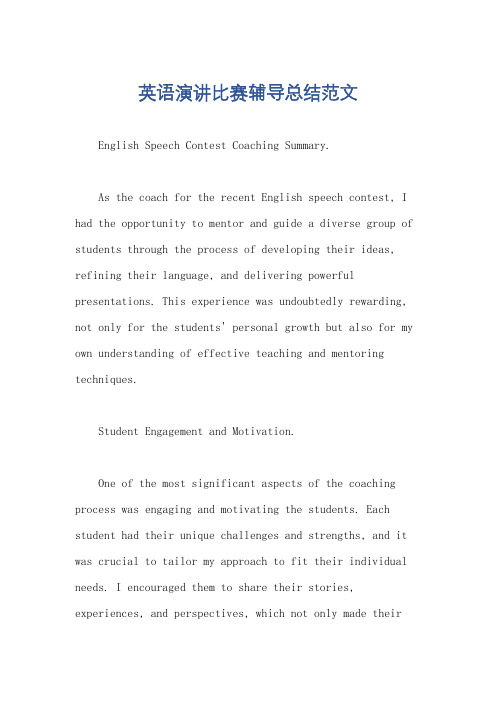
英语演讲比赛辅导总结范文English Speech Contest Coaching Summary.As the coach for the recent English speech contest, I had the opportunity to mentor and guide a diverse group of students through the process of developing their ideas, refining their language, and delivering powerful presentations. This experience was undoubtedly rewarding, not only for the students' personal growth but also for my own understanding of effective teaching and mentoring techniques.Student Engagement and Motivation.One of the most significant aspects of the coaching process was engaging and motivating the students. Each student had their unique challenges and strengths, and it was crucial to tailor my approach to fit their individual needs. I encouraged them to share their stories, experiences, and perspectives, which not only made theirspeeches more authentic but also helped them connect with their audience.I emphasized the importance of preparation and practice, challenging the students to think critically about their topics and to present their ideas with clarity and confidence. I also recognized the importance of providing a safe and supportive learning environment where studentsfelt comfortable taking risks and trying new things.Speech Content and Delivery.Content was, of course, key to the success of each speech. I worked with the students to identify relevant and engaging topics that resonated with their audiences. We discussed the structure of their speeches, ensuring that they had a clear introduction, well-developed body paragraphs, and a strong conclusion. I emphasized the importance of using examples, anecdotes, and otherrhetorical devices to bring their points to life and make their arguments more persuasive.Delivery was also crucial. I coached the students on effective use of voice, pace, and tone to capture the attention of their listeners. We practiced breathing exercises and worked on physical presence, ensuring that each student appeared comfortable and confident on stage. I also emphasized the importance of eye contact and maintaining a strong connection with the audience throughout the speech.Challenges and Solutions.During the coaching process, we encountered various challenges. Some students struggled with public speaking anxiety, while others had difficulty condensing their ideas into a concise speech. To address these issues, I implemented various strategies. For example, we practiced relaxation techniques and confidence-building exercises to help students overcome their anxiety. I also encouraged them to brainstorm and outline their ideas, helping them to distill their thoughts into a manageable and impactful speech.Reflection and Future Plans.Overall, the experience of coaching the English speech contest was incredibly rewarding. I am proud of the progress that the students made and the confidence that they gained throughout the process. However, there is always room for improvement, and I plan to refine my coaching techniques and strategies in the future.In the future, I plan to focus more on individualizing my approach, recognizing that each student has unique needs and strengths. I also want to explore additional resources and techniques to help students overcome public speaking anxiety and to further develop their language and presentation skills.In conclusion, coaching the English speech contest was a valuable experience that taught me not only about effective teaching and mentoring techniques but also about the potential and resilience of young learners. I look forward to continuing to support and challenge thesestudents as they continue to grow and develop as public speakers and leaders.。
英语演讲心得5篇

英语演讲心得5篇英语演讲的心得体会篇1终于,精心预备的公开课星期一上午第三节在多媒体教室结束了,心底长长地呼了一口气,脑中那根紧绷的弦稍稍放松一下,从预备这节课到上完,中间的过程使我学到了许多的学问,也明白了公开课对于一位年轻老师的成长有着重要的作用,在这次备课中,虽然费了许多脑汁,但我的收获确是不能用文字来表达的,很感谢校领导给了我这次历练、成长的机会、感谢师傅张老师这几天的辛苦和细致的指导、感谢英语组老师的点评以及确定、鼓励。
回想这段时间来预备这次课的过程,有些许感想体会。
记得上次城区公开课,学校给了我一个很好的熬炼机会,我也确实努力预备了一番,很想把它完成好,但课下的精心设计安排等到真正上课时才发觉并没有达到预想到的效果。
缺乏熬炼、阅历不足、课堂驾驭能力不够、再加上我急于胜利,很快就把缺点暴露出来了。
虽然上次讲课失败了心里有些遗憾,但回头想想那段时间的预备使我收获颇多,学到了平常在课堂上不留意的细节问题。
它也是我成长过程中的一次宝贵经历。
我相信人是在不断挫折和失败中慢慢磨练和提高的,只有正视自己的缺点和不足才会有进步,通过上次的熬炼使我能够快速成长。
这次学校组织的公开课,我首先把心态放好,专心选课,精心设计教案,利用周末时间在家里备课、看优质课光盘从中学习和充实自己,这次课中间穿插的嬉戏、chant、和歌曲环节使我费劲脑汁。
我对自己要求这次肯定要把课讲好,这次公开课家人也很支持我协作我,主动要求给我当学生,而且做得很称职,很专心,小组读,个人读,男女生读,每一遍他都像学生一样一个单词不拉地去跟读,给我制造上课的气氛,并且用相机拍下每一次讲的情况,依据不足之处,共同分析,加以改进,给我供应了很大的帮忙。
这次制作课件的过程中也使我从中收获了不少学问,每一张幻灯片中所需要的图片和声音一点一点从网上下载,其中有一张幻灯片是插入一首family歌曲,为了从网上下载带动画的歌曲短片插入到课件中需要转换格式才行,我又下了一个转换格式的软件,晚上试了一次又一次还是不行最终我较上了劲做不好就不睡,终于功夫不负有心人做到早上四点多才算制作好,当时很兴奋也不困了感觉自己很有成就感。
演讲的总结汇报稿英语范文
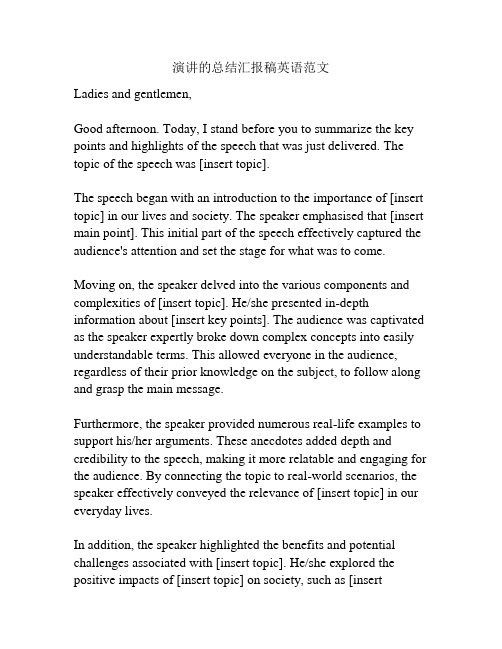
演讲的总结汇报稿英语范文Ladies and gentlemen,Good afternoon. Today, I stand before you to summarize the key points and highlights of the speech that was just delivered. The topic of the speech was [insert topic].The speech began with an introduction to the importance of [insert topic] in our lives and society. The speaker emphasised that [insert main point]. This initial part of the speech effectively captured the audience's attention and set the stage for what was to come.Moving on, the speaker delved into the various components and complexities of [insert topic]. He/she presented in-depth information about [insert key points]. The audience was captivated as the speaker expertly broke down complex concepts into easily understandable terms. This allowed everyone in the audience, regardless of their prior knowledge on the subject, to follow along and grasp the main message.Furthermore, the speaker provided numerous real-life examples to support his/her arguments. These anecdotes added depth and credibility to the speech, making it more relatable and engaging for the audience. By connecting the topic to real-world scenarios, the speaker effectively conveyed the relevance of [insert topic] in our everyday lives.In addition, the speaker highlighted the benefits and potential challenges associated with [insert topic]. He/she explored the positive impacts of [insert topic] on society, such as [insertbenefits]. However, the speaker also acknowledged the potential obstacles that may arise, specifically [insert challenges]. By acknowledging both the advantages and disadvantages, the speaker demonstrated a well-rounded understanding of the topic and conveyed a sense of realism.Lastly, the speech concluded with a call to action. The speaker urged the audience to [insert action]. This call to action not only served to motivate and inspire the audience, but also left them with a sense of empowerment and responsibility to act upon the knowledge gained from the speech.In conclusion, the speech on [insert topic] was an enlightening and thought-provoking experience. The speaker successfully conveyed the importance and relevance of [insert topic], while providing comprehensive information and captivating examples. The speech left the audience with a deeper understanding and appreciation for [insert topic], as well as a sense of urgency to take action. Thank you.。
英语演讲总结观点

英语演讲总结观点引言英语演讲是培养学生口语表达和自信心的重要课程之一。
通过演讲,学生不仅能够提高英语口语能力,还能够锻炼思维逻辑和表达能力。
本文总结了我在参加英语演讲课程中的一些观点和体验,包括演讲技巧、主题选择、观众互动等方面。
演讲技巧1.自信心:在进行英语演讲时,自信心是十分重要的。
只有充满自信地面对观众,才能够自如地展示自己的观点和表达能力。
为了增加自信心,我会提前准备演讲内容,并进行多次练习,熟悉内容并增强对自己的信心。
2.清晰明了的语言:在英语演讲中,语言表达要尽可能地清晰明了。
避免使用过于复杂的词汇和句子结构,以免让观众难以理解。
简洁明了的语言能够让观众更容易理解和接受演讲内容。
3.流畅的表达:流畅的表达是一个好演讲的关键。
我通过大量阅读英语文章和练习口语交流来提高自己的英语表达能力。
此外,了解常用的口语表达和交际技巧也有助于提高演讲的流畅度。
4.肢体语言:在演讲过程中,适当运用肢体语言可以更好地表达自己的观点和情感。
比如,用手势强调重要观点,保持良好的站姿和目光交流等等。
适度的肢体语言可以增加演讲的生动性和吸引力。
主题选择1.个人经历:分享个人经历是一个常见的演讲主题选择。
通过以自己为例,能够更生动地表达出观点,使演讲内容更有感染力。
例如,我曾经在一次演讲中分享了自己的留学经历,向观众们展示了留学带给我的积极影响和成长。
2.社会问题:选择与观众生活相关的社会问题作为演讲主题,能够引起观众的共鸣,并增加演讲的影响力。
例如,我曾演讲过关于环境保护和气候变化的话题,引发了观众们的思考和讨论。
3.文化交流:以文化交流为主题,分享不同地区、不同国家的文化差异和交流经验。
这样的主题能够增加观众对其他文化的了解,并促进多元文化交流。
例如,我曾经在演讲中介绍了中国的传统节日和习俗,引起了观众们的兴趣与好奇。
观众互动与观众的互动是英语演讲中不可或缺的一部分。
通过与观众的互动,能够增加演讲的活跃度和吸引力。
英语演讲总结
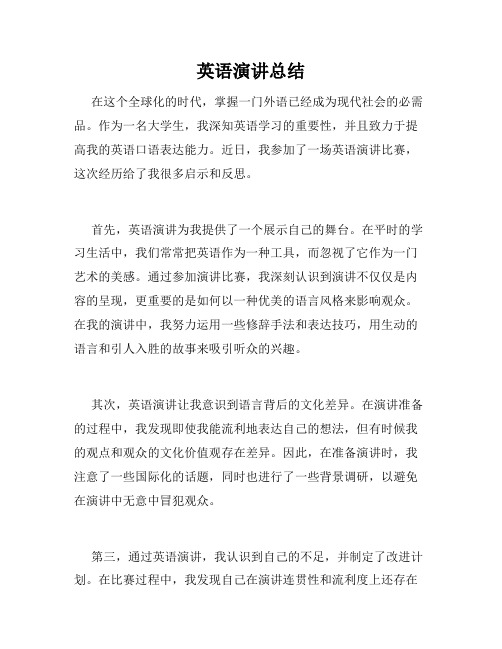
英语演讲总结在这个全球化的时代,掌握一门外语已经成为现代社会的必需品。
作为一名大学生,我深知英语学习的重要性,并且致力于提高我的英语口语表达能力。
近日,我参加了一场英语演讲比赛,这次经历给了我很多启示和反思。
首先,英语演讲为我提供了一个展示自己的舞台。
在平时的学习生活中,我们常常把英语作为一种工具,而忽视了它作为一门艺术的美感。
通过参加演讲比赛,我深刻认识到演讲不仅仅是内容的呈现,更重要的是如何以一种优美的语言风格来影响观众。
在我的演讲中,我努力运用一些修辞手法和表达技巧,用生动的语言和引人入胜的故事来吸引听众的兴趣。
其次,英语演讲让我意识到语言背后的文化差异。
在演讲准备的过程中,我发现即使我能流利地表达自己的想法,但有时候我的观点和观众的文化价值观存在差异。
因此,在准备演讲时,我注意了一些国际化的话题,同时也进行了一些背景调研,以避免在演讲中无意中冒犯观众。
第三,通过英语演讲,我认识到自己的不足,并制定了改进计划。
在比赛过程中,我发现自己在演讲连贯性和流利度上还存在一定的不足。
有时候,我会陷入断句、停顿的陷阱,导致整个演讲效果不佳。
因此,我决定通过更多的练习来提高口语流利度,增加与他人进行讨论和辩论的机会,为自己积累更多的英语口语经验。
此外,英语演讲也让我发现了自己的优势和独特之处。
在比赛过程中,我成功地利用了一些幽默元素,令听众开怀大笑。
这给了我很大的自信和动力,以更大的勇气去尝试创新和突破。
我也希望通过更多实践的机会,进一步挖掘并发展自己的特长。
总结起来,英语演讲是我提高英语口语表达能力的重要途径。
通过演讲,我不仅可以展示自己,还可以借助语言艺术的力量来影响观众。
这次经历让我认识到语言背后的文化差异,也激励我不断改进自己。
我相信,通过不断地练习和努力,我会在英语演讲的道路上取得更大的进步。
在接下来的学习中,我将继续参与各种演讲活动,不断提升我在英语演讲方面的能力。
同时,我希望能够与其他同学共同学习,互相交流和分享经验。
- 1、下载文档前请自行甄别文档内容的完整性,平台不提供额外的编辑、内容补充、找答案等附加服务。
- 2、"仅部分预览"的文档,不可在线预览部分如存在完整性等问题,可反馈申请退款(可完整预览的文档不适用该条件!)。
- 3、如文档侵犯您的权益,请联系客服反馈,我们会尽快为您处理(人工客服工作时间:9:00-18:30)。
课程总结
其实选这门课本身是个意外,以我英语四级没通过的水平本没指望上这听起来就很高大上的英语公共演讲,但人生就是总有意外,我不小心选了,还错过了退课时间,于是只有硬着头皮上。
但是,此刻我无比庆幸我选择了这门在我看来很难很难的课。
在这半年里,我学会的不仅是英语演讲的技巧和方法,更多的是从演讲中感觉到了英语的乐趣,我可以说的不那么高深,我只用我仅有的英语能力去构筑我想告诉大家的东西,可能用词不是那么正确,语法也不一定都对,发音也不那么标准,但这是真正融入了我的感情,我的想法,是我拼命想表达的话,其中掺入的,是我的激情,我想这也许就是演讲的魅力吧。
在这半年里,我进行了3次演讲,没有心情从紧张到平静,我一直都紧张,也许说是激动更好,我觉得演讲让我真正体会到了语言的迷人,原来英语在我眼里更多的印象是阅读、听力、写作,不同的题型,不同的答题技巧和写作模版,曾经我心中的英语,没有自由。
而越是接触英语演讲,越是发现,原来语言还可以这样用,不仅表达你想表达的内容,甚至可以影响别人。
这半年说实话真的很感谢刘老师,您真的是我见过的最温柔的英语老师,不论我们犯了什么错误,您都会特别温柔的指正,在我第一次演讲忐忑万分的时候很真诚的鼓励我,给我继续面对众人开口的勇气,谢谢您。
就写这么多吧,我还会继续发现英语的美好,演讲的美好,我也永远会记得我上过的这门课,最后,刘老师祝您一切都好!
学生
王凯洁12103109。
